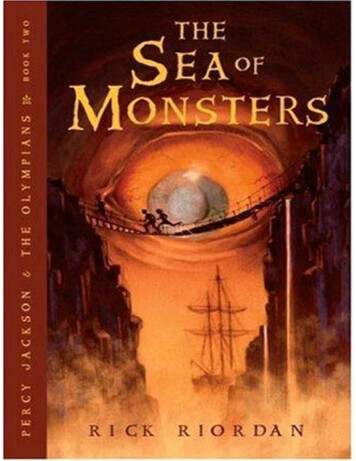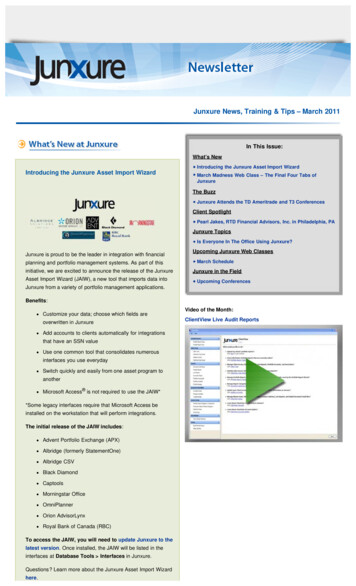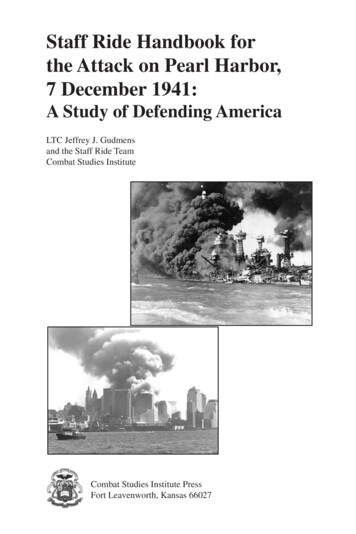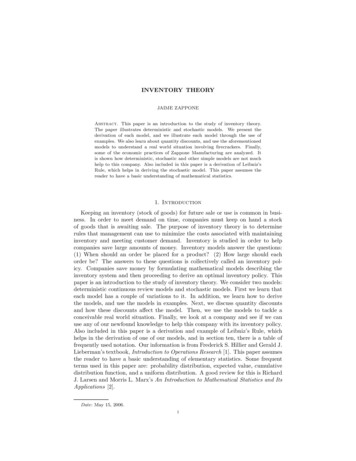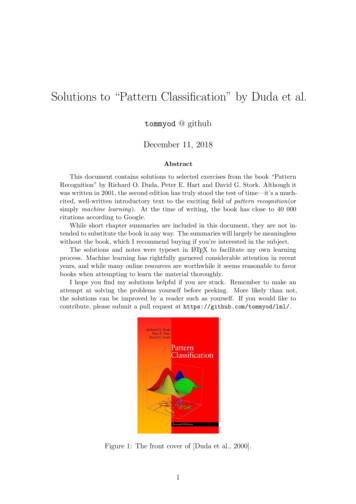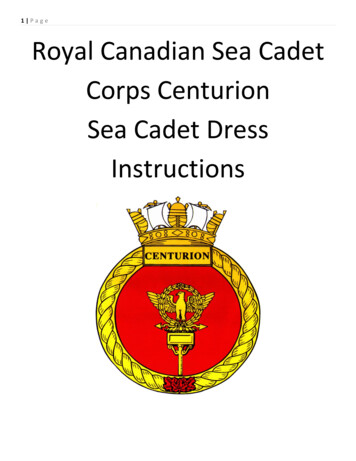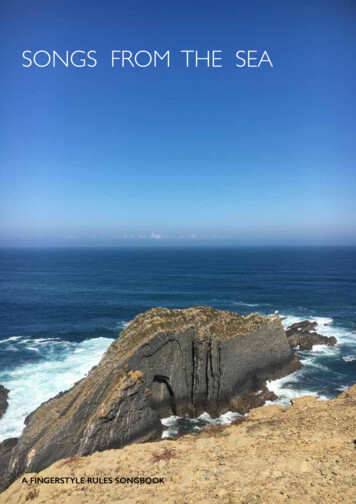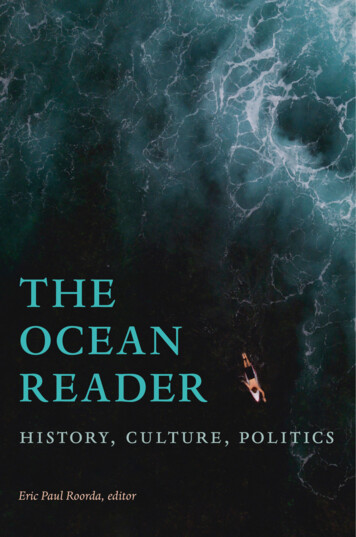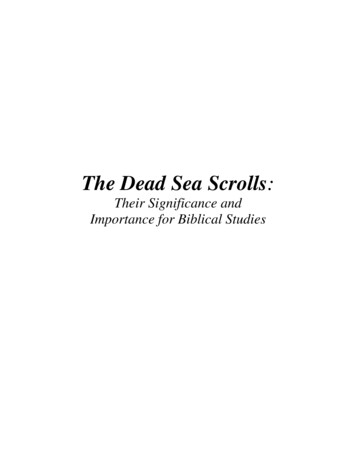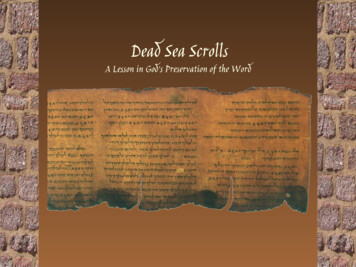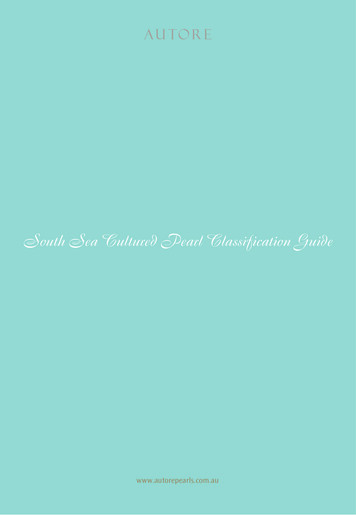
Transcription
South Sea Cultured Pearl Classification Guidewww.autorepearls.com.au
Over the centuries, pearls have enjoyed a rich and varied history. Finding a pearl was considereda miracle of nature. As the years went by, man developed the culturing process to help this uniquegem continue to thrive. Today, the majority of pearls sold around the world are cultured.This AUTORE classification guide refers to the process of classifying South Sea cultured pearls. Autore Pearls Pty Ltd.No material may be reproduced in part or in whole without the written consent of the copyright holders.www.autorepearls.com.au
Of all the pearls across the globe, there is one that is rare and revered. In pristine waters wherethe temperature is gentle and the atmosphere nurturing, there is a pearl with a strange perfectionwhich bears the fingerprint of forever, the South Sea pearl.The South Sea pearl is a labour of love, spending two silent years within the host oyster – thePinctada maxima (commonly known as the silver or gold lip) or the Pinctada margaritifera(commonly known as the black lip). The breathtaking gift that is finally delivered into ourworld is well worth the wait.Each pearl is judged and valued on AUTORE’s Five S’s TM. These five specific virtues are: Shine,Surface, Shade, Shape and Size.
ShineAs in all things, true beauty comes from within, so the virtue rated above all others in a South Seapearl is its lustre. Lustre is the result of light reflected from the pearl’s surface combined with itsdeep inner glow (iridescence). South Sea pearls are made up of many fine layers of a crystal-likesubstance called nacre, comprising of organic and inorganic materials secreted from within theliving tissue of the oyster. The quality and thickness of nacre gives a pearl both its radiance and itsdeep glow. The combination of light reflecting on the pearl’s surface and light refracting betweeneach layer of nacre within the pearl is what makes this gem unique. Lustre has the magic tominimise other imperfections and is considered the soul of the pearl.There are five broad categories of lustreIBrilliant lustre: producing a mirror reflectionIIExcellent lustre: producing a very clear reflectionIII Good lustre: producing a good reflectionIV Average lustre: the reflection appears opaqueVPoor lustre: producing very little reflectionIIIIIIIVV
SurfaceThere are two essentials aspects to be considered when assessing the surface of a pearl: blemishesand the pearl’s grain.BLEMISHESThe surface of a pearl is essentially its skin. Because South Sea pearls have layers of lustrous nacrebuilt up over time, a flawless surface is extremely rare. As pearls are a gift of nature from a livingmollusc, the most beautiful and valuable pearls may still have slight imperfections which appear inthe form of small blemishes. These naturally bestowed ‘beauty marks’ characterise each pearl as anindividual creation. Blemishes come in many varieties. The most common blemishes are listed below.1. Spot: the most common type of blemish, which usually appears as a small, shallow hole,a sunken area or a small indented scar on the pearl’s surface2. Bump: a blemish resembling a raised scar or blister. Bumps are uneven and sometimesdiscoloured areas of the pearl’s surface3. Chip: an area of the pearl’s surface which appears to be cut out or chipped off4. Scratch: a mark resembling a line produced by scratching5. Wrinkle: small creases on the pearl’s outer layer producing a crumpled or shrunken appearance12345
A grading system has been developed by AUTORE to identify the extent of visible blemishes,regardless of type. Sometimes an individual pearl or strand can be classified with more than oneof these grades. A single pearl, in this case, would mean it is in between grades and a strand wouldbe made of pearls with different grades.A.Blemish free or very small blemishes hardly discernable by the naked eyeB1.One to four visible blemishes concentrated on one small area of the pearlB2.Blemishes visible on 30% of the pearl’s surface, not necessarily on the same areaC1.Blemishes visible on 50% or more of the pearl’s surface, not necessarily in the same areaC2.Heavy blemishes on the majority of the pearl’s surfaceD.Heavy or deep blemishes and/or thin coating of nacreAB1B2C1C2DThe grading of a Baroque pearl differs from all other South Sea pearl shapes. Its grade is basedpredominantly on its shape, surface appearance and its ability to be diversely used in jewellery andstrands, rather than by reference to its surface blemishes and pearl grain.A. Smooth skin with good lustre however not necessarily spotlessB. Smooth skin with good lustre, spotted or wrinkled on less than 30% of the pearl’s surfaceC. Extremely asymmetrical, spotted or wrinkled on less than 30% of the pearl’s surfaceD. A ‘D’ grade baroque pearl could be classified on the following characteristics:Heavy spotting on the majority of the pearl’s surfaceHeavy wrinkling on the majority of the pearl’s surfaceDiscolouration under the pearl’s surface
PEARL GRAINThe pearl grain refers to the composition of the pearl’s skin and its structure. The tighterthe structure of the pearl, the less evident is its grain. The grain will appear as slight rippleson the pearl’s surface.In cases where the grain is only just visible, it will give the pearl a slightly fractured appearance.As these fractures become larger and more evident, they will appear as ‘cracks’ within the structureof the pearl.CL (CLEAR)No pearl grain visibleVSL (VERY SLIGHT) Very slight pearl grain visibleSL (SLIGHTSlight pearl grain visible on 30% of the pearl’s surfaceMD (MEDIUM)Medium pearl grain visible on 50% or more of the pearl’s surfaceHY (HEAVYHeavy pearl grain visible on entire pearl surfaceFor example, a perfectly clean pearl with a very slight grain will be considered an A/VSL.In the case where a pearl is still perfectly clean but where the grain is clearly visible, appearingas ‘cracks’, the pearl will be classified as a A/MD or A/HY.CLVSLSLMDHY
ShadeThe species of oyster and the environment in which they grow are the main factors behinddetermining a pearl’s colour and complexion. South Sea pearls are highly coveted for their rich,varied colours. Pearls from the Pinctada maxima oyster come in shades of White, Ivory, Silver, Blue,Yellow and rich Gold. Pearls from the Pinctada margaritifera oyster (referred to as Tahitian or Blackpearls) come in shades of Aubergine, Blue, Green and Grey, all with various hues. Every pearl reflectscolour in a different way – boldly on the surface or hinting at hues from within layers of nacre.South Sea pearl colours can be categorised as belonging to either a White, Yellow or Black range:WHITE RANGEWhiteIvorySilverGreyBlueYELLOW RANGECreamYellowGreenChampagne RoseGoldBLACK RANGEAubergineGreen PeacockGreenPeacock GreenSea GreenLimeBlueRoyal Blue PeacockGreyGrey Royal BlueGrey GreenGrey AubergineCOLOUR DEPTH/VARIATIONSAll of the base colours come in dark and light forms. Some South Sea pearls may be labeledas ‘intense’ when their colour is extremely deep or ‘light’ when there is a soft hint of colour.Colour codeI IntenseL LightVariations of these base colours occur quite often and in some cases two colours canbe combined. The appropriate description for pearls combining two colours would beI SIL/BLU (Intense Silver Blue) or L YEL/GRN (Light Yellow Green).
WHITE lowGreenChampagne RoseGoldCRYELGRNCHRGLDYELLOW RANGEBLACK RANGEAubergineGreen PeacockGreenPeacock GreenSea GreenLimeAUGRN PEAGRNPEA GRNSEA GRNLIMBlueRoyal Blue PeacockGreyGrey Royal BlueGrey GreenGrey AubergineBLUROY BLU PEAGRYGRY ROY BLUGRY GRNGRY AUThese black pearl images are copyright protected - Pacific Pearl Colors Poema color chart (www.pacificpearlcolors.pf)
HUESouth Sea pearls often show beautiful iridescent overtones, especially pinks and greens. These huescome from the layered structure of nacre and the behaviour of light as it reflects from both theupper and lower layers of the pearl’s surface.In some cases, more than one hue is visible. To categorise this, the dominant hue will be listed firstfollowed by the more subtle hue, this is classified as ‘slight’ (SL). For example WH/PK SL GRN (WhitePink Slight Green).Colour is a highly subjective quality and current market demands may result in higher prices forsome colours more than for others. However, it is important to remember that although colour addsto the beauty of a pearl, it does not solely determine its allure. Shine, Surface, Shade, Shape and Sizecombine to make each South Sea pearl unique.The pearl colours printed in the AUTORE Pearl Classification Guide are generally accurate. However,colour variations, particularly in relation to the range of possible hues must be allowed for. Formore information on an exact pearl colour reference, please consult an industry-approved pearlpantone guide.
PINKWhite PinkGreen PinkGold PinkWH PKGRN PKGLD PKWhite GreenSilver GreenGold GreenWH GRNSIL GRNGLD GRNSilver BluePink BlueGreen BlueSIL BLUPK BLUGRN BLUGREENBLUE
ShapeSouth Sea pearls come in a variety of shapes, making them an incredibly difficult gem to classifywithout a professionally trained eye. A product of nature, each pearl is individual and unique.The major categories of South Sea pearl shapes are; Round, Near Round, Drop, Button, Baroqueand Circle. With the exception of Round and Near Round pearls, there is a variation of differenttypes within each shape category. However, to simplify pearl shapes, some general principlescan be applied.
ROUNDPearls are formed in oysters seeded with a spherical bead (nucleus) made from freshwater musselshell. Only a small percentage of harvested pearls are perfectly round. As a broad principle,a pearl is considered Round when the variation in its diameter is less than 2.5%. Therefore, a pearlmeasuring 10mm can have up to 0.25mm variance and a pearl measuring 20mm can have up to0.50mm variance.ABThe difference between diameter Aand diameter B is less than 2.5%NEAR ROUNDA pearl is classified Near Round rather than Round when the variation in its diameter is roughlymore than 2.5 %. This percentage may vary when there are lumps or slight variations to the pearl’sshape. Near Round pearls are ideal for jewellery and strand making as they appear round once set.AABThe difference between diameter A and diameter B must be more than 2.5%B
DROPThere are several types of pearls that fall within the Drop shape category. They include Teardrop,Oval and Egg shaped pearls, as well as the more unusual Semi Drop and Cone shapes. Whilevariations in the category can be quite dramatic, the one basic principle is that the vertical axis ofa Drop pearl must always be longer than its horizontal axis. Short Oval shaped pearls can be similarto Near Round pearls in appearance. The greater the difference in size between the vertical axis andthe horizontal axis, the more unusual and rare the pearl is.Vertical AxisHorizontal AxisThe vertical axis of a Drop must alwaysbe longer than its horizontal axisTear DropLong DropShort DropEggShort OvalTE DRLO DRSH DREGSH OVLong OvalSemi DropShort Semi DropSemi OvalConeLO OVSE DRSH SE DRSE OVCO DR
BUTTONAs with the Drop category, Buttons can also vary dramatically in appearance. However, in directcontrast to a Drop pearl, the vertical axis of a Button pearl must always be shorter than itshorizontal axis. High Button pearls can be similar to Near Round pearls in appearance.Vertical AxisThe vertical axis of a Button pearl mustalways be shorter than its horizontal axisHorizontal AxisHigh ButtonMedium ButtonDome ButtonHI BUTME BUTDO BUTCone ButtonLow ButtonDisc ButtonCO BUTLO BUTDI BUT
BAROQUEThe Baroque pearl is the most individual South Sea pearl produced by the Pinctada maxima oyster.Generally speaking, a Baroque pearl is irregular or free form in shape. If the Baroque pearl isrelatively symmetrical, it can be used in a number of different ways in jewellery and strands.Occasionally, Baroque pearls will have what are called ‘Fish Tails’. In some circumstances, one sideof a Baroque pearl will be symmetrical or round, these pearls are classified as Semi Baroque.PebbleBoulderNuggetPearSemi BaroqueFish TailDouble BoulderPEB BRQBO BRQNU BRQPE BRQSE BRQFI TA BRQDO BO BRQPebbleBoulderNuggetPearSemi BaroqueFish TailDouble BoulderPEB BRQBO BRQNU BRQPE BRQSE BRQFI TA BRQDO BO BRQ
CIRCLEA pearl that has one or more parallel grooves etched around its circumference is called a Circle.All shapes can be classified as Circle pearls if these rings or grooves are present. The only exceptionis when a Drop pearl has a ring around its apex, in which case the pearl is classified as a Semi Dropand not a Circle.Circle Category1 One to two grooves2 Three or more grooves but still good reflection3 Multiple grooves distorting reflection1111222333
Non-BeadedKESHIPossessing an individual allure entirely different to that of a nucleated cultured pearl, a non-beadedSouth Sea pearl (‘Keshi’) is created by chance when the oyster rejects the nucleus but retains themantle tissue, that was originally inserted for the creation of the pearl sac. This enables the oyster tocontinue to secrete nacre which forms the ‘Keshi’ pearl.SizeSouth Sea pearls are renowned for their large sizes. The Pinctada maxima oyster is the largestspecies of oyster capable of producing a pearl.South Sea pearls are measured in millimetres. South Sea pearls commonly range from 9-20 mm,with the majority falling within a range of 10-17mm. Though extremely rare, the irregularly shapedBaroque South Sea pearl can reach sizes up to 40mm or more. The largest fine quality Round SouthSea pearl cultivated by one of AUTORE’s South Sea pearl producers, Cygnet Bay Pearls, measured inat a magnificent 22.8mm.Pearls are generally measured using a milligauge which can measure the pearl to within 0.01mmaccuracy. The exception is in relation to the size of Baroque pearls which are usually impossibleto measure by milligauge because of their irregularity. Consequently, Baroque pearls are measuredby sieve.The lines indicate the points at which the diameter of each pearl is measured.
WEIGHTThe weighing unit for pearls is momme, an old Japanese measure of weight still used for all pearls.One momme is equal to 3.75 grams or 18.75 ctsValuesAll of the five virtues (Shape, Surface, Shade, Shine, Size) affect the value of the South Sea pearl.Below AUTORE identifies some basic values used to assess each virtue.SHINEAs far as the pearl lustre is concerned, the more lustrous the pearl, the higher its value.IIIIIIIVVMost ValuableLeast ValuableSURFACEAs with lustre, the less blemishes and pearl grain on the surface, the more valuable the pearl.AB1CLMost ValuableB2VSLC1SLC2MDDHYLeast ValuableBlemishesPearl Grain
SHADEIn terms of colour, basic principles apply to determine the value of South Sea pearls. Howeverthis does not mean that a particular colour is less desired or coveted than another. For example,a deep unusual green could be highly sought after due to its extreme rarity.Being a gem created by nature, there are obviously some exceptions.GoldSilverWhiteIvoryBlueChampagne RoseGreyCreamYellowGreenMost ValuableLeast ValuableSHAPEIn principle, when referring to Shape, the scale of value is reflected a follows:RDNRDDRBUTMost ValuableBARCIRLeast ValuableHowever, there can be some exceptions when referring to a very unusual shape. For example,a very long Drop or perfect Tear Drop may sometimes be more valuable than a Round in the samesize due to the rarity of such a pearl. The same would apply to an unusually shaped and lustrousBaroque as it would be more valuable than a Drop, due to its rarity.SIZEWith size, the larger the pearl, the greater its value.
Abbreviations GuideSHAPESCOLOURSROUND .RDWHITE RANGEWhite.WHIvory .IVSilver .SILGrey .GRYBlue .BLUNEAR ROUND .NRDDROP.DRTear Drop .TE DRLong Drop.LO DRShort Drop .SH DREgg .EGShort Oval.SH OVLong Oval.LO OVSemi Drop .SE DRShort Semi Drop .SH SE DRSemi Oval.SE OVCone .CO DRBUTTON.BUTHigh Button .HI BUTMedium Button .ME BUTDome Button .DO BUTCone Button .CO BUTLow Button .LO BUTDisc Button .DI BUTBAROQUE .BRQPebble .PEB BRQBoulder .BO BRQNugget .NU BRQPear .PE BRQSemi Baroque .SE BRQFish Tail.FI TA BRQDouble Boulder .DO BO BRQCIRCLE.CIRKESHI .KEYELLOW RANGECream .CRYellow .YELGreen .GRNChampagne Rose .CHRGold .GLDBLACK RANGEAubergine .AUGreen Peacock .GRN PEAGreen .GRNPeacock Green .PEA GRNSea Green.SEA GRNLime .LIMBlue .BLURoyal Blue Peacock .ROY BLU PEAGrey .GRYGrey Royal Blue.GRY ROY BLUGrey Green .GRY GRNGrey Aubergine .GRY AU
HUEPINK .PKWhite Pink .WH PKGreen Pink.GRN PKGold Pink .GLD PKGREEN.GRNWhite Green .WH GRNSilver Green.SIL GRNGold Green .GLD GRNBLUE .BLUSilver Blue.SIL BLUPink Blue.PK BLUGreen Blue .GRN BLUCOLOURS VARIATIONSIntense .ILight .LSlight .SLPEARL GRAINClear .CLVery Slight .VSLSlight .SLMedium .MDHeavy.HY
AUTORE HEAD OFFICEGovernor Macquarie Tower, Level 32/1 Farrer Place, Sydney NSW 2000 AUSTRALIAT: 61 2 9285 2222 F: 61 2 9285 2255pearl@autorepearls.com.auAUTORE PEARLING41 Herbert Street, Broome, WA 6725 AUSTRALIAT: 61 891936156 F: 61 891937476clipperpearls@clipperpearls.com.auPT AUTORE PEARL CULTUREJalan Permuda No. 26, Mataram, Lombok NTB 83125 INDONESIAT: 62 370641740 F: 62 s.com.au
www.autorepearls.com.au
A. Blemish free or very small blemishes hardly discernable by the naked eye B1. One to four visible blemishes concentrated on one small area of the pearl B2. Blemishes visible on 30% of the pearl's surface, not necessarily on the same area C1. Blemishes visible on 50% or more of the pearl's surface, not necessarily in the same area C2.
